MARKETING
Pillar Pages: Why and How You Should Add Them to Your Content Strategy

The author’s views are entirely his or her own (excluding the unlikely event of hypnosis) and may not always reflect the views of Moz.
In a recent study, we found that our pillar pages are magnets for links, organic traffic, and newsletter subscribers — especially compared to regular blog posts. Here are the results that both types of SEO content generated over the course of a year:
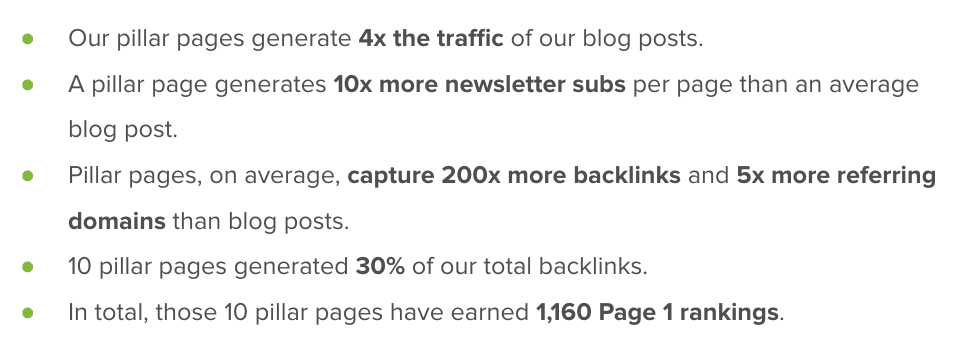
Do these results mean you should ditch your blog strategy in favor of pillar pages? Not exactly.
Here’s the catch: You really can’t have one without the other, and it all comes down to content mapping. I’ll explain exactly what I mean in this article.
What is a pillar page?
A pillar page is a piece of content that comprehensively covers a broad topic. Pillar page — also sometimes referred to as hub and spoke — content weaves together a wide range of relevant subtopics (spokes), organizes them all in one place (hub), and effectively showcases your subject matter expertise for the broad topic.
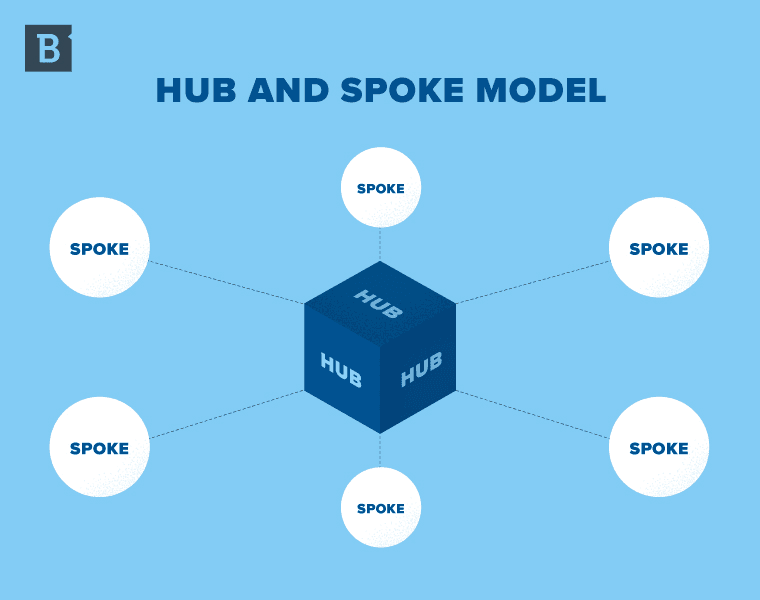
Pillar page content should be easy to navigate for readers looking to learn — at a high level — about a particular topic, but should also offer relevant resources for them to dive deeper.
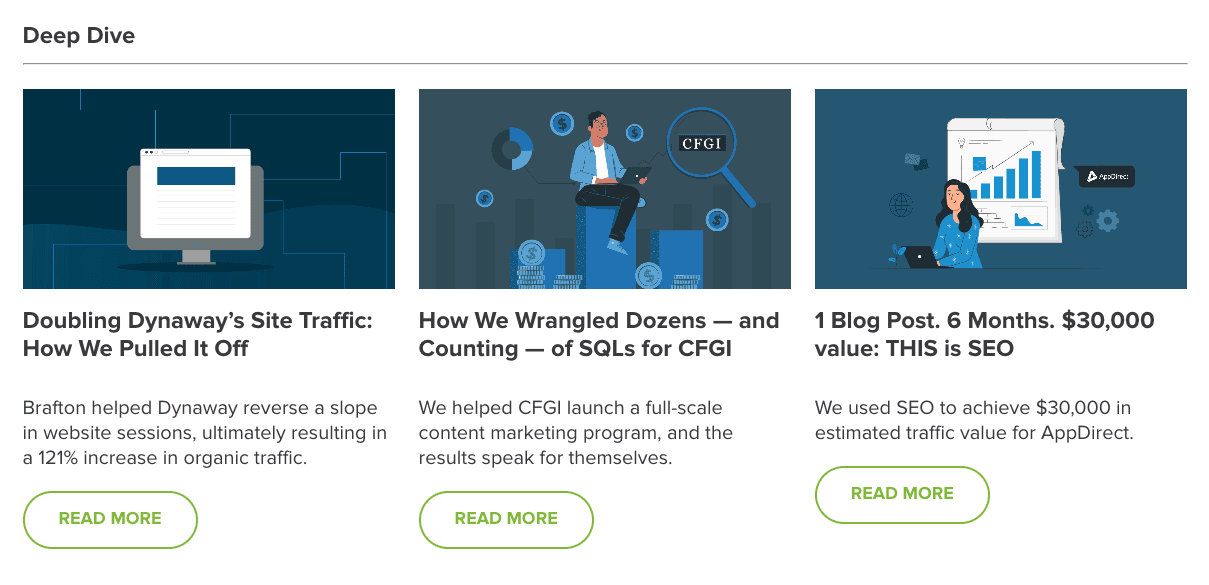
It’s kind of like the choose-your-own-adventure of content marketing.
Topical authority: why it’s important
When it comes to content creation for SEO and digital marketing, you don’t want to create content around any old topic. Instead, you want to reinforce your brand’s topical authority with every new piece of content you create (be it a blog, a pillar page, an eBook, etc.).
Let’s put it this way: If you’re in the business of selling mechanical keyboards, it doesn’t make sense to publish a blog article about the best recipes for a summer BBQ. Unless you’re recommending that your customers grill and eat their mechanical keyboards, which is (highly) unlikely.
Instead, it’s more helpful to your brand — and your audience — if you cover topics related to mechanical keyboards, like:
-
What is a mechanical keyboard?
-
Mechanical keyboards vs. regular keyboards.
-
Custom mechanical keyboards.
-
How to transition to a mechanical keyboard.
-
Pros and cons of a mechanical keyboard.
By covering as many topics related to mechanical keyboards as possible, you’re building a foundation of informational content that tells search engines: “Hey, I know a lot about mechanical keyboards!”
And the more content you have that starts to rank for important search terms related to mechanical keyboards, the more likely searchers will see you as an authority on the subject. Ideally, they will start coming back to your content when they need to learn more about this specific topic.
Pillar pages + blogs = a match made in content marketing heaven
A well-executed and organized pillar page is one of the best ways to showcase to your audience (and search engines) that you have topical authority in a specific area. Blog posts help you achieve topical authority by allowing you to cover a wide range of relevant subtopics in great detail, and pillar pages organize all of that content into a nice, user-friendly package.
Let’s take a look at this tactic in action.
We built our content marketing guide as a pillar page, which allowed us to cover a slew of subtopics related to the broader topic of content marketing, all in one piece of collateral.
All of these subtopics are organized into sections on the page, with a hyperlinked table of contents at the top to allow readers to pick and choose exactly what they’d like to learn about:
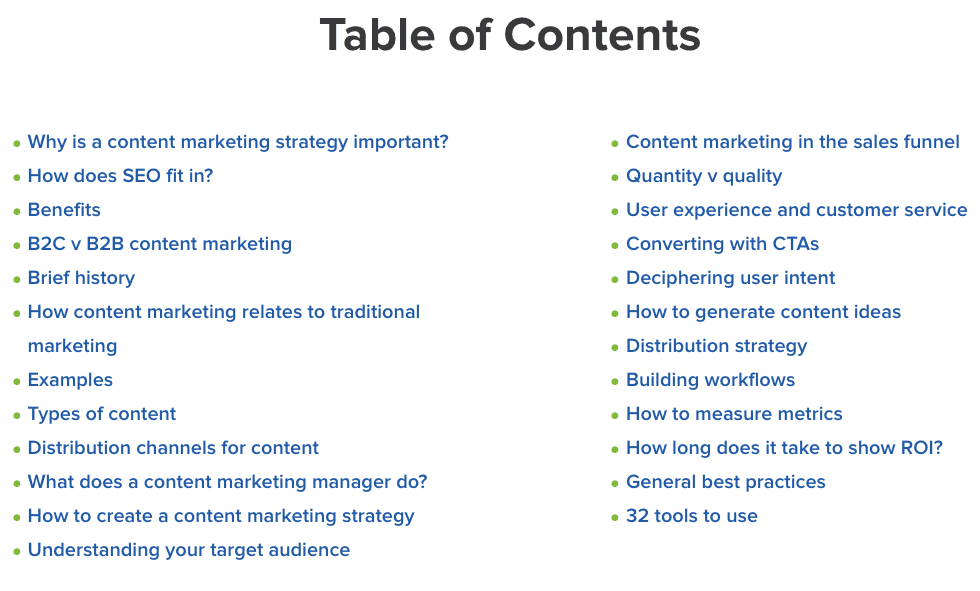
Then, throughout the page, we offer readers the opportunity to go deeper and learn more about each subtopic by linking to relevant blog content:
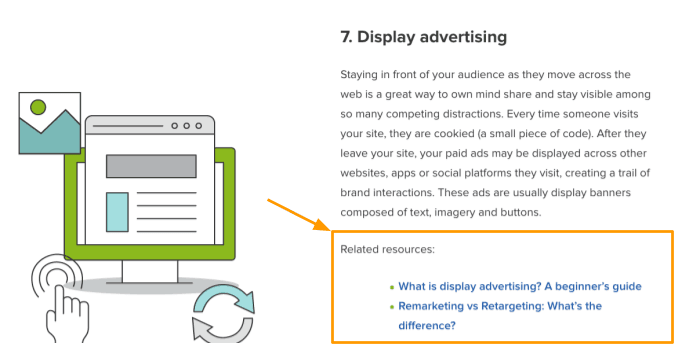
What is content mapping?
A pillar page is a great tactic if you’ve got a lot of existing blog content all focused on a particular parent topic. It’s one of our favorite ways at Brafton to repurpose and repromote our blogs.
But you can also create a pillar page with all brand-new content — it’ll just take more research, planning, and production time to complete.
Enter: content mapping.
Content mapping is the process of assessing your target audience, understanding what they are trying to achieve, and helping them along that journey with branded educational and commercial content. Its scope can span the entirety of your content marketing strategy or a single piece of pillar page content.
Why content mapping matters in content marketing
The planning (or content mapping) of a pillar page is just as important as the research done to choose the correct keyword to target for your business.
Pillar pages are kind of like the books of the marketing world. If you were an expert birder, for example, you wouldn’t set out to write a book about bird-watching without doing any research. Especially if you’ve spent a lot of time writing and publishing articles about bird-watching on your blog. You’d want to understand a few things before starting that book, like:
-
Which of my blog posts generated the most interest from new and returning readers? (i.e. pages with the most new and returning visitors, as seen in your web analytics tool).
-
Which blogs kept readers coming back for more? (i.e. pages with the most newsletter subscriptions, or the best newsletter subscription rates).
-
Which blogs did my industry peers find most useful? (i.e. pages with the greatest number of high-quality referring domains and backlinks).
These questions can be answered by looking through your web analytics tools, such as Google Analytics and Moz Pro.
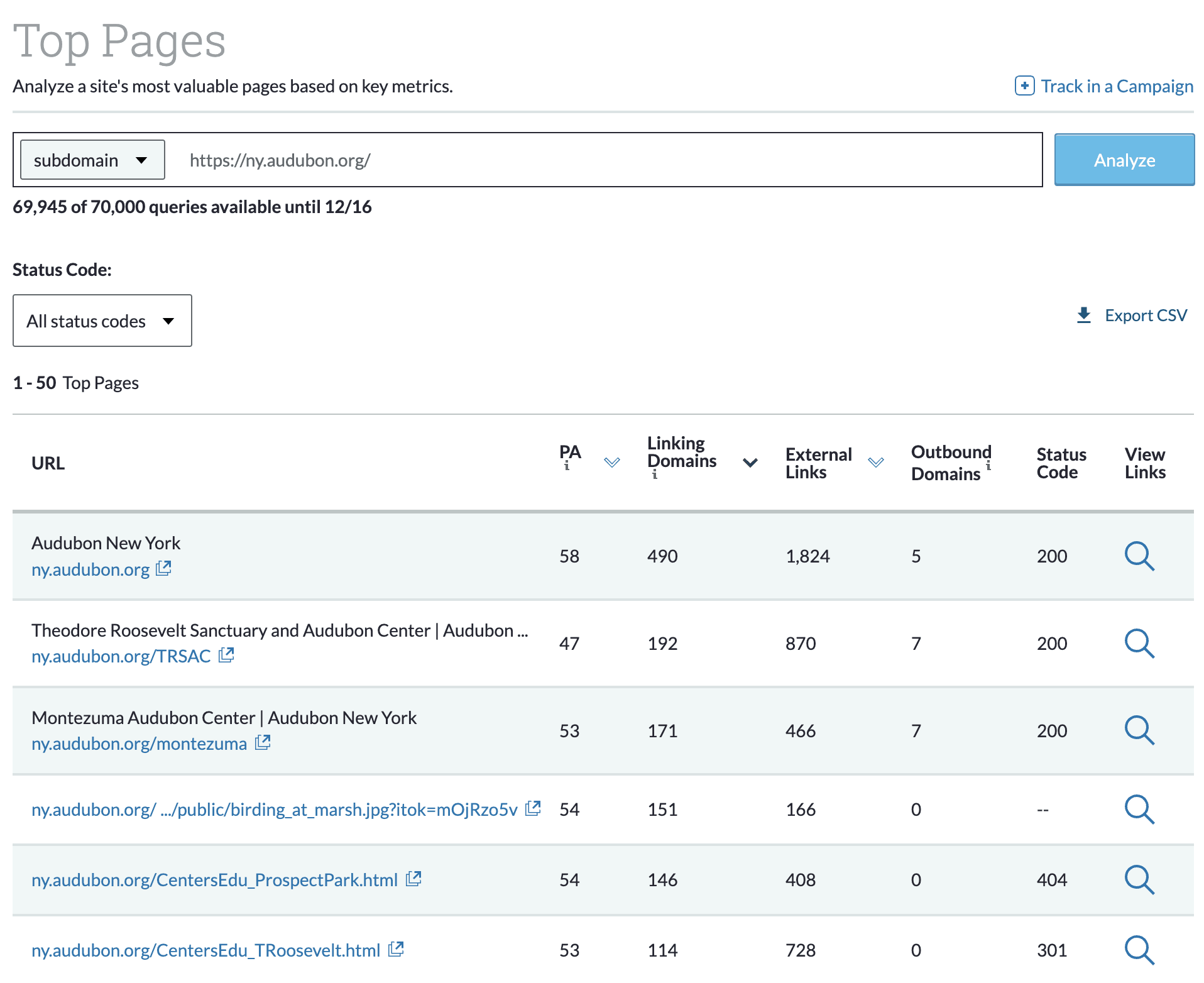
You’d also want to understand what the competition looks like before you spend dozens of hours writing thousands of words to fill a book.
You’d want to answer questions, like:
-
What do my competitors’ books on bird-watching look like? (i.e. the types of bird-watching subtopics the page 1 results cover).
-
What does Google think searchers want to see when they search for bird-watching? (i.e. the types of content that are found on page 1 for your target keyword — and surprise! it might not be books).
-
How long and detailed are my competitors’ books? (i.e. the level of complexity and comprehensiveness of the content ranking on page 1).
These questions can be answered by manually reviewing relevant SERPs and utilizing TF-IDF tools like Clearscope or MarketMuse to understand the breadth of subtopics and types of content ranking on the first page.
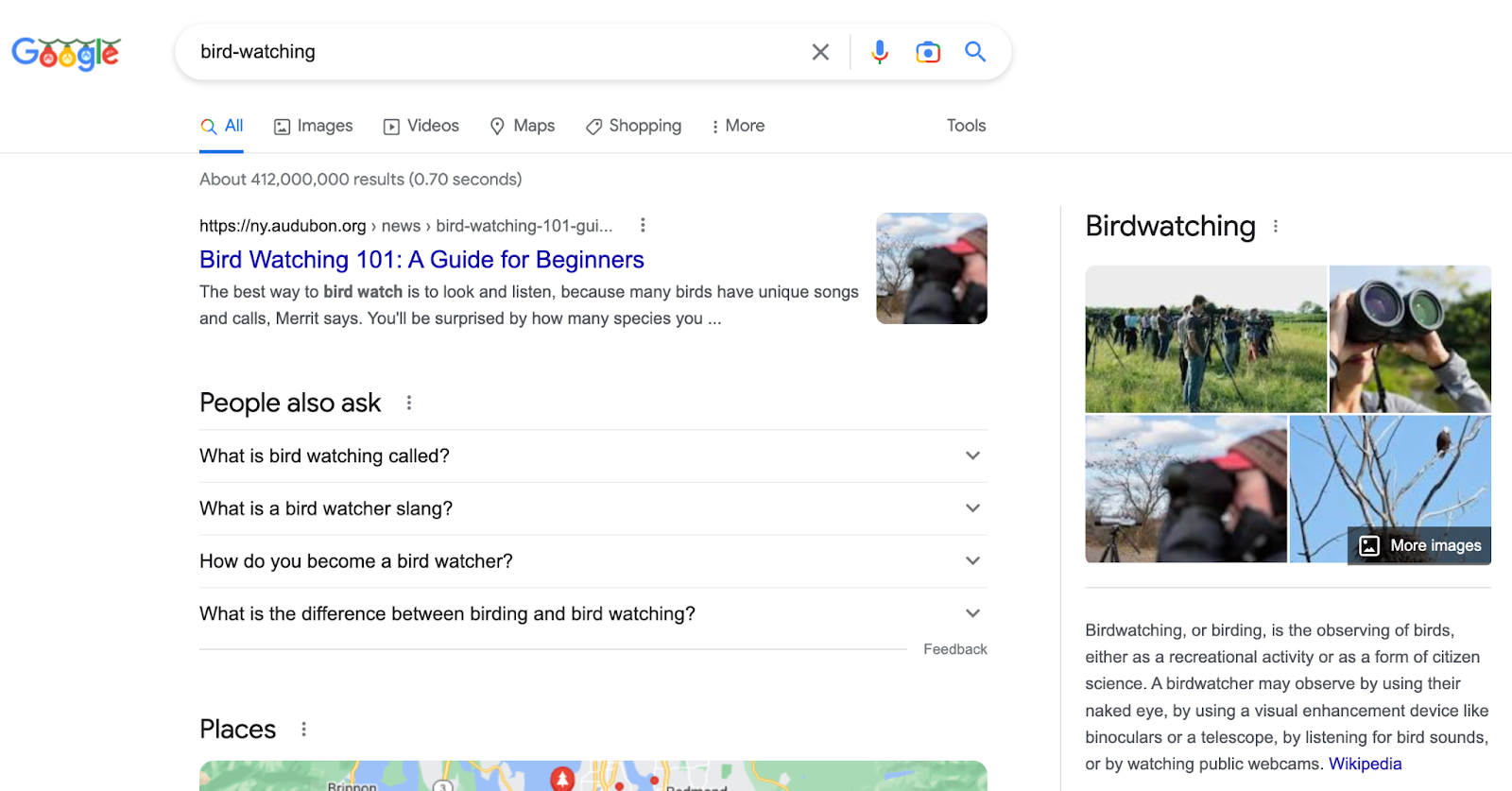
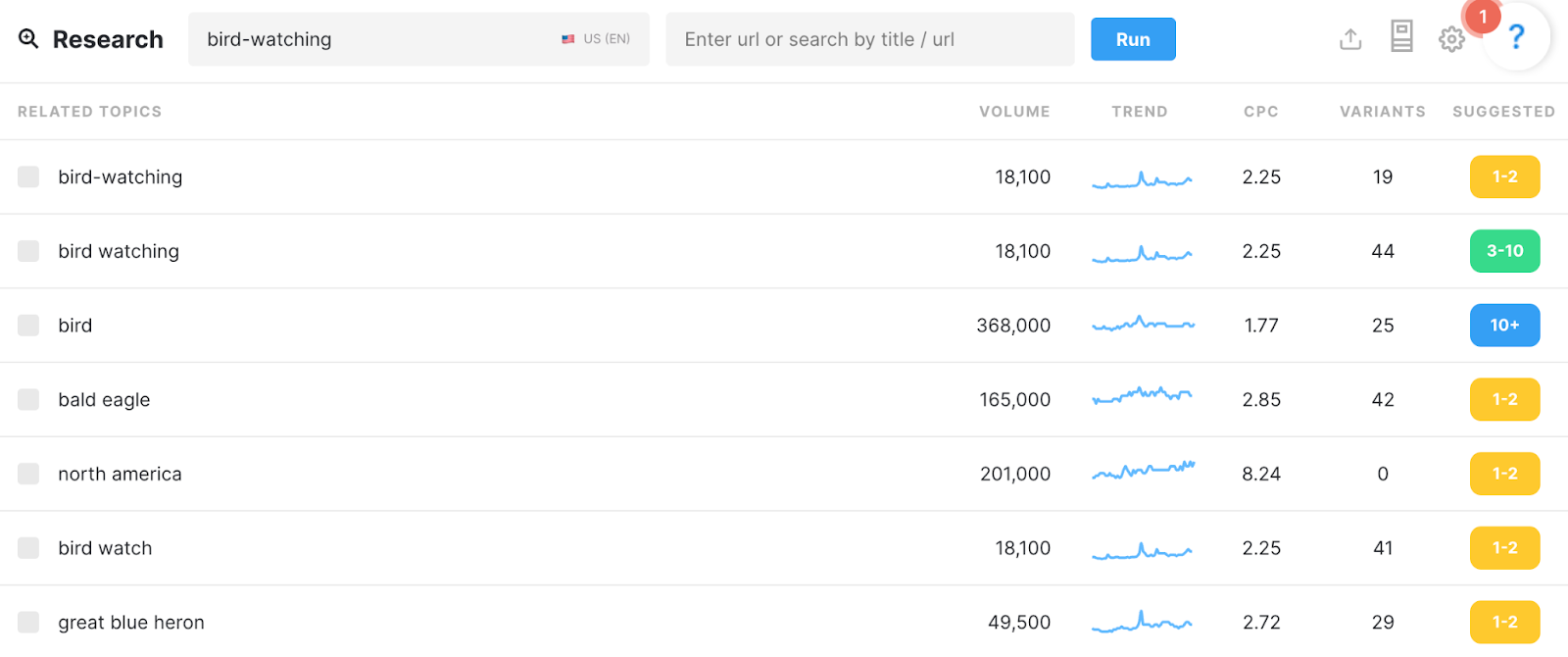
Once you understand which of your content performs best and which content Google and other search engines prefer to rank highly for your target keyword, you can start piecing together a plan for your pillar page.
A note about internal linking
Before we dive into the how-to portion of this piece, we should also acknowledge the importance of internal linking to this whole process.
And I’m not just talking about throwing in a link to a related product/service at the end of the page and calling it a day. The internal linking structure of your pillar page is literally the glue that holds the whole thing together. It helps readers easily navigate to related resources to continue learning from your brand. And it helps search engines understand the relationship between your pillar page content and the additional content you’re highlighting on the page.
But when it comes to internal linking, there is such a thing as too much of a good thing.
Including too many internal links throughout your content can cause a frustrating user experience or look spammy, so use caution and make sure the only internal linking you do on the page is extremely relevant to the parent topic.
If you’re unsure whether or not you’ve got too many internal links on the page, you can run it through Moz’s On-Page Grader tool, which automatically counts the number of links on your page and flags if you’ve got too many.
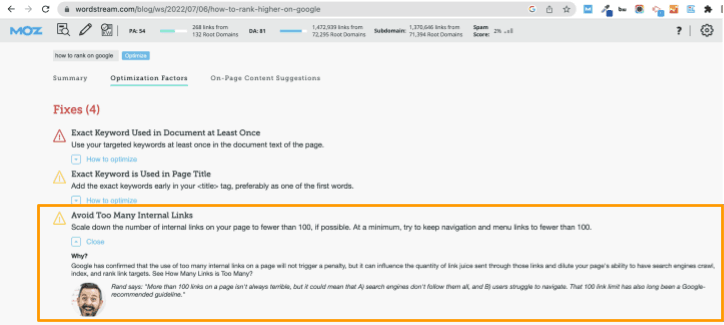
Tip: Keep in mind that this tool will count ALL links found on the page, including those in your main navigation and footer, so the “Too Many Links” warning could be a false positive.
As Moz explains: Google recommends you don’t go over 100 internal links per page, because it can dilute the SEO value sent from the pillar page to the linked pages, and it can also make it more challenging for users and crawlers to navigate all of the content.
Two data-led ways to map out content for a pillar page
There are a couple of different ways to approach the construction of this type of content, but they each rely on organic search data to lead the way.
1. Planning a pillar page and related resources (all from scratch)
Let’s pretend you don’t have any prior content created about a particular topic. You’re basically starting from scratch. Let’s also assume the topic you’ve selected is both core and commercially valuable to your business, and that your domain realistically has a chance of ranking on page 1 for that keyword.
Let’s say you’re a pet food company and one of your main products is cat dental treats. Once you’ve determined that this is the exact keyword you want to target (“cat dental treats”), it’s time to start your research.
Step 1: Manually inspect SERP to understand searcher intent
First, we’ll start by manually inspecting the first SERP for this keyword, and answering the following questions:
-
What types of content are on the first page of results?
-
Why are people searching for “cat dental treats”?
By answering these two questions in our SERP analysis, we’ll make sure that our plan for creating a pillar page to rank actually makes sense and it’s what searchers want to see on the SERP. We’ll also better understand all the reasons behind why someone might search this keyword (and we can then address those reasons in the content we create).
So let’s answer these questions:
Question 1: What types of content are on the first page of results?
Answer 1: The first SERP includes a variety of product ads, a People Also Ask section, and a selection of organic blogs and product pages.

Question 2: Why are people searching for “cat dental treats”?
Answer 2: From a quick analysis of the SERP, we can deduce that people want to know why and how cat dental treats are important to a cat’s health, and they also want to know which cat dental treats work best. Perhaps most importantly, it’s highly likely that they plan to purchase cat dental treats for their furry companion(s) in the near future.
Step 2: Select related keyword ideas for blog content
Since you don’t just want to create a pillar page for just the primary keyword, you also want to pinpoint a selection of related subtopics to be written as blog content.
For this part of the process, head over to your keyword research tool, plug in your target keyword and (with an eye for topics that you’re well-suited to cover), jot down a list of keywords and phrases.
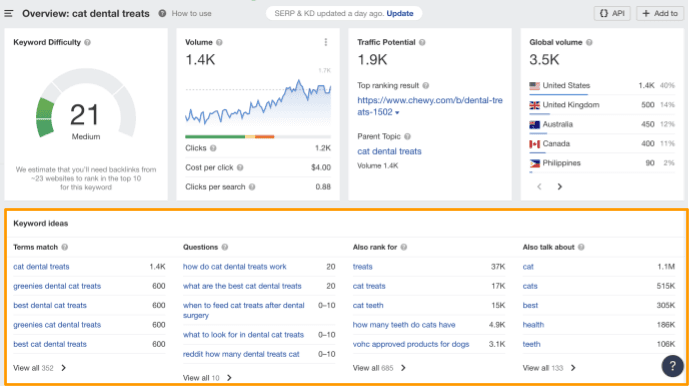
Here’s our list of potential blog topics:
-
Best cat dental treats.
-
How do cat dental treats work?
-
What to look for in cat dental treats.
-
Do cat dental treats work?
-
Can cat dental treats replace brushing?
-
Vet recommended cat dental treats.
-
Grain-free cat dental treats.
Step 3: Choose subtopics to cover in your pillar page content
Next, you’ll want to review the subtopics mentioned in the top ranking results. While this process can be done manually (by clicking into each result on the SERP and jotting down the topics mentioned), a TF-IDF tool like MarketMuse makes this part of the process much quicker:
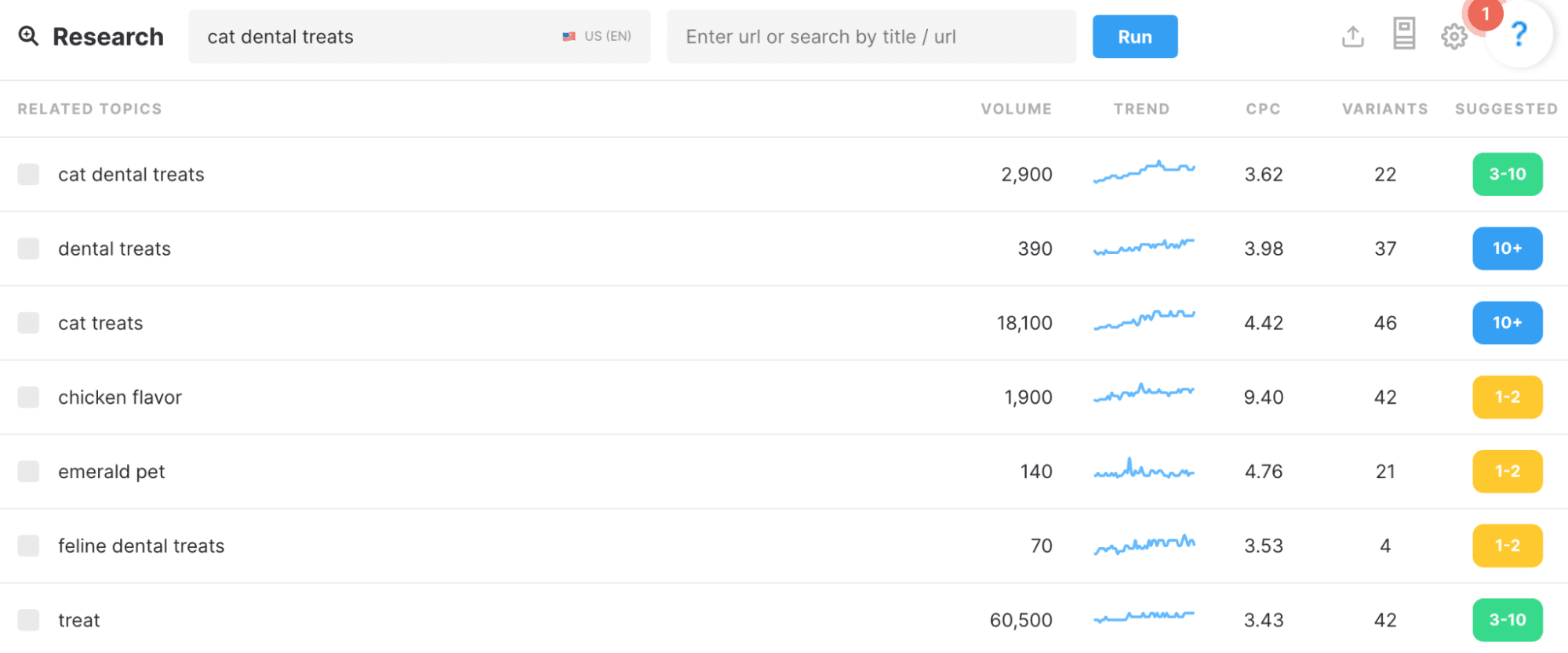
These TF-IDF tools analyze the top 10-20 results for your target keyword and automatically present the common subtopics mentioned in each piece. This gives you a very good understanding of what you’ll also need to cover in your piece to compete for a top-ranking spot.
Here’s the list of subtopics we’ll want to cover in this pillar page, based on our MarketMuse data:
Step 4: Create your outline and plan content
Now it’s time to connect the dots from your research. The best way to do this is to start by structuring your pillar page outline, and then going back in and filling in the areas where you want to create supporting blog content.
Here’s an example of what the end result might look like:
H1: The Complete Guide to Cat Dental Treats: For a Fresh-Breath Feline Friend
H2: What are cat dental treats and how do they work?
- Topics to cover: Cat dental treats
- Blog post to support section:
Title: How Cat Dental Treats Work (& Why Your Kitty Needs Them)
Keyword: how do cat dental treats work
H2: What are the benefits of cat dental treats?
- Topics to cover: Clean teeth, fresh breath
- Blog post to support section:
Title: Do Cat Dental Treats Really Work? (Here’s What The Experts Say)
Keyword: do cat dental treats work
H2: Are cat dental treats an acceptable alternative to brushing?
- Topics to cover: Cats dental health
- Blog post to support section:
Title: Cat Dental Treats Vs Brushing: Everything You Need To Know
Keyword: can cat dental treats replace brushing
H2: Do vets recommend using cat dental treats?
- Topics to cover: Veterinary oral health council
- Blog post to support section:
Title: Vets Recommend Using Cat Dental Treats — Here’s Why
Keyword: vet recommended cat dental treats
H2: The best cat dental treats to try
- Topics to cover: Purina dentalife, Feline greenies, natural ingredients, artificial flavors.
- Blog post to support section:
Title: 5 Of The Best Cat Dental Treats & Why We Love Them
Keyword: best cat dental treats - Blog post #2 to support section:
Title: What To Look For In Cat Dental Treats
Keyword: what to look for in cat dental treats
Creating an outline for a pillar page isn’t easy, but once laid out, it helps us understand the content that needs to be produced to bring the whole thing to life.
Here is our list of content to create (based on our outline):
-
Pillar page: The Complete Guide to Cat Dental Treats: For a Fresh-Breath Feline Friend
-
Blog #1: How Cat Dental Treats Work (& Why Your Kitty Needs Them)
-
Blog #2: Do Cat Dental Treats Really Work? (Here’s What The Experts Say)
-
Blog #3: Cat Dental Treats Vs Brushing: Everything You Need To Know
-
Blog #4: Vets Recommend Using Cat Dental Treats — Here’s Why
-
Blog #5: 5 Of The Best Cat Dental Treats & Why We Love Them
-
Blog #6: What To Look For In Cat Dental Treats
The best way to tackle this list of content is to create and publish the six blog posts first, then once they are live, you can write the pillar page content, placing hyperlinks to the supporting blog posts directly in the copy.
2. Planning a pillar page from top performing content
For this next method, let’s say you already have a ton of published content about a particular topic, and you’d like to reuse and repromote that content within a pillar page dedicated to that topic.
All of the steps in the previous process apply, but for Step 2 (Select Related Keyword Ideas for Blog Content), do the following:
First, you’ll want to understand which of your existing pieces generates the most interest from your audience. Let’s use our web analytics data for this. In this example, we’ll look at Google Search Console data because it shows the actual search performance of our website content.
Let’s use the topic of “content creation” as our desired pillar page keyword. Search for the query in Google Search Console (choose the “Queries containing” option):

Pull all of the pages currently generating impressions and clicks from terms containing your topic, placing those with the highest clicks and impressions at the top of your list. Here’s what this might look like:

As you can see, most of the content we’ve created that also ranks for keywords containing “content creation” is blog content. These will be highly useful as related resources on our pillar page.
Now, go back to your TF-IDF tool and select the subtopics related to “content creation” that you want to cover in your pillar page. Example:
-
Social media content
-
Content creation tool
-
Content creators
-
Content strategy
-
Content creation process
Finally, map your existing blog content to those “content creation” subtopics. The initial mapping may look something like this:

You may not be able to map each blog perfectly to the subtopic you’re covering in your pillar page, but that’s OK. What’s important is that you’re providing readers with relevant content (where applicable) and that content, as you’ve seen in your Search Console data, is already proven to perform well with your organic search audience.
Pillar page planning templates and resources
Pillar pages take an incredible amount of time and planning to execute, but they are worth every penny.
Here’s an example of the success we saw after producing one of our more recent pillar pages, “How to Rank on Google:”
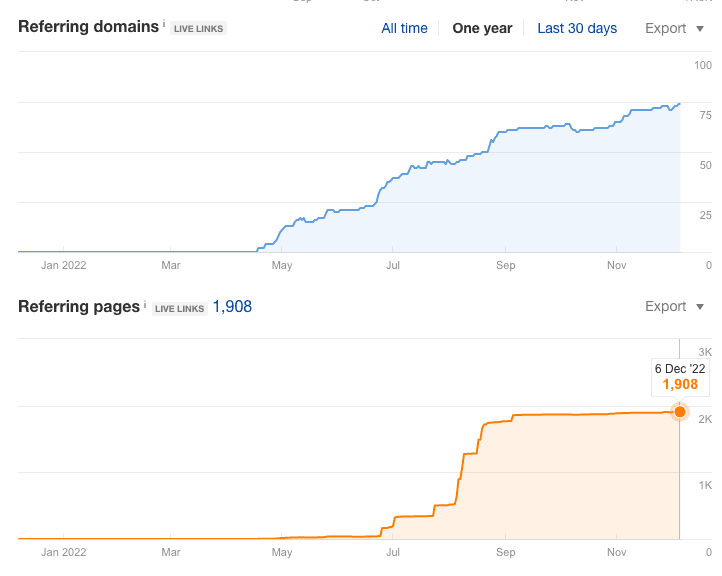
Here’s a template of the outline used to bring the page to life (and you can use it for your own pillar page). Just make a copy and off you go. Good luck!
MARKETING
Should Your Brand Shout Its AI and Marketing Plan to the World?

To use AI or not to use AI, that is the question.
Let’s hope things work out better for you than they did for Shakespeare’s mad Danish prince with daddy issues.
But let’s add a twist to that existential question.
CMI’s chief strategy officer, Robert Rose, shares what marketers should really contemplate. Watch the video or read on to discover what he says:
Should you not use AI and be proud of not using it? Dove Beauty did that last week.
Should you use it but keep it a secret? Sports Illustrated did that last year.
Should you use AI and be vocal about using it? Agency giant Brandtech Group picked up the all-in vibe.
Should you not use it but tell everybody you are? The new term “AI washing” is hitting everywhere.
What’s the best option? Let’s explore.
Dove tells all it won’t use AI
Last week, Dove, the beauty brand celebrating 20 years of its Campaign for Real Beauty, pledged it would NEVER use AI in visual communication to portray real people.
In the announcement, they said they will create “Real Beauty Prompt Guidelines” that people can use to create images representing all types of physical beauty through popular generative AI programs. The prompt they picked for the launch video? “The most beautiful woman in the world, according to Dove.”
I applaud them for the powerful ad. But I’m perplexed by Dove issuing a statement saying it won’t use AI for images of real beauty and then sharing a branded prompt for doing exactly that. Isn’t it like me saying, “Don’t think of a parrot eating pizza. Don’t think about a parrot eating pizza,” and you can’t help but think about a parrot eating pizza right now?
Brandtech Group says it’s all in on AI
Now, Brandtech Group, a conglomerate ad agency, is going the other way. It’s going all-in on AI and telling everybody.
This week, Ad Age featured a press release — oops, I mean an article (subscription required) — with the details of how Brandtech is leaning into the takeaway from OpenAI’s Sam Altman, who says 95% of marketing work today can be done by AI.
A Brandtech representative talked about how they pitch big brands with two people instead of 20. They boast about how proud they are that its lean 7,000 staffers compete with 100,000-person teams. (To be clear, showing up to a pitch with 20 people has never been a good thing, but I digress.)
OK, that’s a differentiated approach. They’re all in. Ad Age certainly seemed to like it enough to promote it. Oops, I mean report about it.
False claims of using AI and not using AI
Offshoots of the all-in and never-will approaches also exist.
The term “AI washing” is de rigueur to describe companies claiming to use AI for something that really isn’t AI. The US Securities and Exchange Commission just fined two companies for using misleading statements about their use of AI in their business model. I know one startup technology organization faced so much pressure from their board and investors to “do something with AI” that they put a simple chatbot on their website — a glorified search engine — while they figured out what they wanted to do.
Lastly and perhaps most interestingly, companies have and will use AI for much of what they create but remain quiet about it or desire to keep it a secret. A recent notable example is the deepfake ad of a woman in a car professing the need for people to use a particular body wipe to get rid of body odor. It was purported to be real, but sharp-eyed viewers suspected the fake and called out the company, which then admitted it. Or was that the brand’s intent all along — the AI-use outrage would bring more attention?
This is an AI generated influencer video.
Looks 100% real. Even the interior car detailing.
UGC content for your brand is about to get really cheap. ☠️ pic.twitter.com/2m10RqoOW3
— Jon Elder | Amazon Growth | Private Label (@BlackLabelAdvsr) March 26, 2024
To yell or not to yell about your brand’s AI decision
Should a brand yell from a mountaintop that they use AI to differentiate themselves a la Brandtech? Or should a brand yell they’re never going to use AI to differentiate themselves a la Dove? Or should a brand use it and not yell anything? (I think it’s clear that a brand should not use AI and lie and say it is. That’s the worst of all choices.)
I lean far into not-yelling-from-mountaintop camp.
When I see a CEO proudly exclaim that they laid off 90% of their support workforce because of AI, I’m not surprised a little later when the value of their service is reduced, and the business is failing.
I’m not surprised when I hear “AI made us do it” to rationalize the latest big tech company latest rounds of layoffs. Or when a big consulting firm announces it’s going all-in on using AI to replace its creative and strategic resources.
I see all those things as desperate attempts for short-term attention or a distraction from the real challenge. They may get responses like, “Of course, you had to lay all those people off; AI is so disruptive,” or “Amazing. You’re so out in front of the rest of the pack by leveraging AI to create efficiency, let me cover your story.” Perhaps they get this response, “Your company deserves a bump in stock price because you’re already using this fancy new technology.”
But what happens if the AI doesn’t deliver as promoted? What happens the next time you need to lay off people? What happens the next time you need to prove your technologically forward-leaning?
Yelling out that you’re all in on a disruptive innovation, especially one the public doesn’t yet trust a lot is (at best) a business sugar high. That short-term burst of attention may or may not foul your long-term brand value.
Interestingly, the same scenarios can manifest when your brand proclaims loudly it is all out of AI, as Dove did. The sugar high may not last and now Dove has itself into a messaging box. One slip could cause distrust among its customers. And what if AI gets good at demonstrating diversity in beauty?
I tried Dove’s instructions and prompted ChatGPT for a picture of “the most beautiful woman in the world according to the Dove Real Beauty ad.”
It gave me this. Then this. And this. And finally, this.
She’s absolutely beautiful, but she doesn’t capture the many facets of diversity Dove has demonstrated in its Real Beauty campaigns. To be clear, Dove doesn’t have any control over generating the image. Maybe the prompt worked well for Dove, but it didn’t for me. Neither Dove nor you can know how the AI tool will behave.
To use AI or not to use AI?
When brands grab a microphone to answer that question, they work from an existential fear about the disruption’s meaning. They do not exhibit the confidence in their actions to deal with it.
Let’s return to Hamlet’s soliloquy:
Thus conscience doth make cowards of us all;
And thus the native hue of resolution
Is sicklied o’er with the pale cast of thought,
And enterprises of great pith and moment
With this regard their currents turn awry
And lose the name of action.
In other words, Hamlet says everybody is afraid to take real action because they fear the unknown outcome. You could act to mitigate or solve some challenges, but you don’t because you don’t trust yourself.
If I’m a brand marketer for any business (and I am), I’m going to take action on AI for my business. But until I see how I’m going to generate value with AI, I’m going to be circumspect about yelling or proselytizing how my business’ future is better.
HANDPICKED RELATED CONTENT:
Cover image by Joseph Kalinowski/Content Marketing Institute
MARKETING
How to Use AI For a More Effective Social Media Strategy, According to Ross Simmonds

Welcome to Creator Columns, where we bring expert HubSpot Creator voices to the Blogs that inspire and help you grow better.
It’s the age of AI, and our job as marketers is to keep up.
My team at Foundation Marketing recently conducted an AI Marketing study surveying hundreds of marketers, and more than 84% of all leaders, managers, SEO experts, and specialists confirmed that they used AI in the workplace.

If you can overlook the fear-inducing headlines, this technology is making social media marketers more efficient and effective than ever. Translation: AI is good news for social media marketers.
In fact, I predict that the marketers not using AI in their workplace will be using it before the end of this year, and that number will move closer and closer to 100%.
Social media and AI are two of the most revolutionizing technologies of the last few decades. Social media has changed the way we live, and AI is changing the way we work.
So, I’m going to condense and share the data, research, tools, and strategies that the Foundation Marketing Team and I have been working on over the last year to help you better wield the collective power of AI and social media.
Let’s jump into it.
What’s the role of AI in social marketing strategy?
In a recent episode of my podcast, Create Like The Greats, we dove into some fascinating findings about the impact of AI on marketers and social media professionals. Take a listen here:
Let’s dive a bit deeper into the benefits of this technology:
Benefits of AI in Social Media Strategy
AI is to social media what a conductor is to an orchestra — it brings everything together with precision and purpose. The applications of AI in a social media strategy are vast, but the virtuosos are few who can wield its potential to its fullest.
AI to Conduct Customer Research
Imagine you’re a modern-day Indiana Jones, not dodging boulders or battling snakes, but rather navigating the vast, wild terrain of consumer preferences, trends, and feedback.
This is where AI thrives.
Using social media data, from posts on X to comments and shares, AI can take this information and turn it into insights surrounding your business and industry. Let’s say for example you’re a business that has 2,000 customer reviews on Google, Yelp, or a software review site like Capterra.
Leveraging AI you can now have all 2,000 of these customer reviews analyzed and summarized into an insightful report in a matter of minutes. You simply need to download all of them into a doc and then upload them to your favorite Generative Pre-trained Transformer (GPT) to get the insights and data you need.
But that’s not all.
You can become a Prompt Engineer and write ChatGPT asking it to help you better understand your audience. For example, if you’re trying to come up with a persona for people who enjoy marathons but also love kombucha you could write a prompt like this to ChatGPT:

The response that ChatGPT provided back is quite good:

Below this it went even deeper by including a lot of valuable customer research data:
- Demographics
- Psychographics
- Consumer behaviors
- Needs and preferences
And best of all…
It also included marketing recommendations.
The power of AI is unbelievable.
Social Media Content Using AI
AI’s helping hand can be unburdening for the creative spirit.
Instead of marketers having to come up with new copy every single month for posts, AI Social Caption generators are making it easier than ever to craft catchy status updates in the matter of seconds.
Tools like HubSpot make it as easy as clicking a button and telling the AI tool what you’re looking to create a post about:

The best part of these AI tools is that they’re not limited to one channel.
Your AI social media content assistant can help you with LinkedIn content, X content, Facebook content, and even the captions that support your post on Instagram.
It can also help you navigate hashtags:

With AI social media tools that generate content ideas or even write posts, it’s not about robots replacing humans. It’s about making sure that the human creators on your team are focused on what really matters — adding that irreplaceable human touch.
Enhanced Personalization
You know that feeling when a brand gets you, like, really gets you?
AI makes that possible through targeted content that’s tailored with a level of personalization you’d think was fortune-telling if the data didn’t paint a starker, more rational picture.
What do I mean?
Brands can engage more quickly with AI than ever before. In the early 2000s, a lot of brands spent millions of dollars to create social media listening rooms where they would hire social media managers to find and engage with any conversation happening online.
Thanks to AI, brands now have the ability to do this at scale with much fewer people all while still delivering quality engagement with the recipient.
Analytics and Insights
Tapping into AI to dissect the data gives you a CSI-like precision to figure out what works, what doesn’t, and what makes your audience tick. It’s the difference between guessing and knowing.
The best part about AI is that it can give you almost any expert at your fingertips.
If you run a report surrounding the results of your social media content strategy directly from a site like LinkedIn, AI can review the top posts you’ve shared and give you clear feedback on what type of content is performing, why you should create more of it, and what days of the week your content is performing best.
This type of insight that would typically take hours to understand.
Now …
Thanks to the power of AI you can upload a spreadsheet filled with rows and columns of data just to be met with a handful of valuable insights a few minutes later.
Improved Customer Service
Want 24/7 support for your customers?
It’s now possible without human touch.
Chatbots powered by AI are taking the lead on direct messaging experiences for brands on Facebook and other Meta properties to offer round-the-clock assistance.
The fact that AI can be trained on past customer queries and data to inform future queries and problems is a powerful development for social media managers.
Advertising on Social Media with AI
The majority of ad networks have used some variation of AI to manage their bidding system for years. Now, thanks to AI and its ability to be incorporated in more tools, brands are now able to use AI to create better and more interesting ad campaigns than ever before.
Brands can use AI to create images using tools like Midjourney and DALL-E in seconds.
Brands can use AI to create better copy for their social media ads.
Brands can use AI tools to support their bidding strategies.
The power of AI and social media is continuing to evolve daily and it’s not exclusively found in the organic side of the coin. Paid media on social media is being shaken up due to AI just the same.
How to Implement AI into Your Social Media Strategy
Ready to hit “Go” on your AI-powered social media revolution?
Don’t just start the engine and hope for the best. Remember the importance of building a strategy first. In this video, you can learn some of the most important factors ranging from (but not limited to) SMART goals and leveraging influencers in your day-to-day work:
The following seven steps are crucial to building a social media strategy:
- Identify Your AI and Social Media Goals
- Validate Your AI-Related Assumptions
- Conduct Persona and Audience Research
- Select the Right Social Channels
- Identify Key Metrics and KPIs
- Choose the Right AI Tools
- Evaluate and Refine Your Social Media and AI Strategy
Keep reading, roll up your sleeves, and follow this roadmap:
1. Identify Your AI and Social Media Goals
If you’re just dipping your toes into the AI sea, start by defining clear objectives.
Is it to boost engagement? Streamline your content creation? Or simply understand your audience better? It’s important that you spend time understanding what you want to achieve.
For example, say you’re a content marketing agency like Foundation and you’re trying to increase your presence on LinkedIn. The specificity of this goal will help you understand the initiatives you want to achieve and determine which AI tools could help you make that happen.
Are there AI tools that will help you create content more efficiently? Are there AI tools that will help you optimize LinkedIn Ads? Are there AI tools that can help with content repurposing? All of these things are possible and having a goal clearly identified will help maximize the impact. Learn more in this Foundation Marketing piece on incorporating AI into your content workflow.
Once you have identified your goals, it’s time to get your team on board and assess what tools are available in the market.
Recommended Resources:
2. Validate Your AI-Related Assumptions
Assumptions are dangerous — especially when it comes to implementing new tech.
Don’t assume AI is going to fix all your problems.
Instead, start with small experiments and track their progress carefully.
3. Conduct Persona and Audience Research
Social media isn’t something that you can just jump into.
You need to understand your audience and ideal customers. AI can help with this, but you’ll need to be familiar with best practices. If you need a primer, this will help:
Once you understand the basics, consider ways in which AI can augment your approach.
4. Select the Right Social Channels
Not every social media channel is the same.
It’s important that you understand what channel is right for you and embrace it.
The way you use AI for X is going to be different from the way you use AI for LinkedIn. On X, you might use AI to help you develop a long-form thread that is filled with facts and figures. On LinkedIn however, you might use AI to repurpose a blog post and turn it into a carousel PDF. The content that works on X and that AI can facilitate creating is different from the content that you can create and use on LinkedIn.
The audiences are different.
The content formats are different.
So operate and create a plan accordingly.
Recommended Tools and Resources:
5. Identify Key Metrics and KPIs
What metrics are you trying to influence the most?
Spend time understanding the social media metrics that matter to your business and make sure that they’re prioritized as you think about the ways in which you use AI.
These are a few that matter most:
- Reach: Post reach signifies the count of unique users who viewed your post. How much of your content truly makes its way to users’ feeds?
- Clicks: This refers to the number of clicks on your content or account. Monitoring clicks per campaign is crucial for grasping what sparks curiosity or motivates people to make a purchase.
- Engagement: The total social interactions divided by the number of impressions. This metric reveals how effectively your audience perceives you and their readiness to engage.
Of course, it’s going to depend greatly on your business.
But with this information, you can ensure that your AI social media strategy is rooted in goals.
6. Choose the Right AI Tools
The AI landscape is filled with trash and treasure.
Pick AI tools that are most likely to align with your needs and your level of tech-savviness.
For example, if you’re a blogger creating content about pizza recipes, you can use HubSpot’s AI social caption generator to write the message on your behalf:

The benefit of an AI tool like HubSpot and the caption generator is that what at one point took 30-40 minutes to come up with — you can now have it at your fingertips in seconds. The HubSpot AI caption generator is trained on tons of data around social media content and makes it easy for you to get inspiration or final drafts on what can be used to create great content.
Consider your budget, the learning curve, and what kind of support the tool offers.
7. Evaluate and Refine Your Social Media and AI Strategy
AI isn’t a magic wand; it’s a set of complex tools and technology.
You need to be willing to pivot as things come to fruition.
If you notice that a certain activity is falling flat, consider how AI can support that process.
Did you notice that your engagement isn’t where you want it to be? Consider using an AI tool to assist with crafting more engaging social media posts.
Make AI Work for You — Now and in the Future
AI has the power to revolutionize your social media strategy in ways you may have never thought possible. With its ability to conduct customer research, create personalized content, and so much more, thinking about the future of social media is fascinating.
We’re going through one of the most interesting times in history.
Stay equipped to ride the way of AI and ensure that you’re embracing the best practices outlined in this piece to get the most out of the technology.
MARKETING
Advertising in local markets: A playbook for success

Many brands, such as those in the home services industry or a local grocery chain, market to specific locations, cities or regions. There are also national brands that want to expand in specific local markets.
Regardless of the company or purpose, advertising on a local scale has different tactics than on a national scale. Brands need to connect their messaging directly with the specific communities they serve and media to their target demo. Here’s a playbook to help your company succeed when marketing on a local scale.
1. Understand local vs. national campaigns
Local advertising differs from national campaigns in several ways:
- Audience specificity: By zooming in on precise geographic areas, brands can tailor messaging to align with local communities’ customs, preferences and nuances. This precision targeting ensures that your message resonates with the right target audience.
- Budget friendliness: Local advertising is often more accessible for small businesses. Local campaign costs are lower, enabling brands to invest strategically within targeted locales. This budget-friendly nature does not diminish the need for strategic planning; instead, it emphasizes allocating resources wisely to maximize returns. As a result, testing budgets can be allocated across multiple markets to maximize learnings for further market expansion.
- Channel selection: Selecting the correct channels is vital for effective local advertising. Local newspapers, radio stations, digital platforms and community events each offer advantages. The key lies in understanding where your target audience spends time and focusing efforts to ensure optimal engagement.
- Flexibility and agility: Local campaigns can be adjusted more swiftly in response to market feedback or changes, allowing brands to stay relevant and responsive.
Maintaining brand consistency across local touchpoints reinforces brand identity and builds a strong, recognizable brand across markets.
2. Leverage customized audience segmentation
Customized audience segmentation is the process of dividing a market into distinct groups based on specific demographic criteria. This marketing segmentation supports the development of targeted messaging and media plans for local markets.
For example, a coffee chain might cater to two distinct segments: young professionals and retirees. After identifying these segments, the chain can craft messages, offers and media strategies relating to each group’s preferences and lifestyle.
To reach young professionals in downtown areas, the chain might focus on convenience, quality coffee and a vibrant atmosphere that is conducive to work and socializing. Targeted advertising on Facebook, Instagram or Connected TV, along with digital signage near office complexes, could capture the attention of this demographic, emphasizing quick service and premium blends.
Conversely, for retirees in residential areas, the chain could highlight a cozy ambiance, friendly service and promotions such as senior discounts. Advertisements in local print publications, community newsletters, radio stations and events like senior coffee mornings would foster a sense of community and belonging.
Dig deeper: Niche advertising: 7 actionable tactics for targeted marketing
3. Adapt to local market dynamics
Various factors influence local market dynamics. Brands that navigate changes effectively maintain a strong audience connection and stay ahead in the market. Here’s how consumer sentiment and behavior may evolve within a local market and the corresponding adjustments brands can make.
- Cultural shifts, such as changes in demographics or societal norms, can alter consumer preferences within a local community. For example, a neighborhood experiencing gentrification may see demand rise for specific products or services.
- Respond by updating your messaging to reflect the evolving cultural landscape, ensuring it resonates with the new demographic profile.
- Economic conditions are crucial. For example, during downturns, consumers often prioritize value and practicality.
- Highlight affordable options or emphasize the practical benefits of your offerings to ensure messaging aligns with consumers’ financial priorities. The impact is unique to each market and the marketing message must also be dynamic.
- Seasonal trends impact consumer behavior.
- Align your promotions and creative content with changing seasons or local events to make your offerings timely and relevant.
- New competitors. The competitive landscape demands vigilance because new entrants or innovative competitor campaigns can shift consumer preferences.
- Differentiate by focusing on your unique selling propositions, such as quality, customer service or community involvement, to retain consumer interest and loyalty.
4. Apply data and predictive analytics
Data and predictive analytics are indispensable tools for successfully reaching local target markets. These technologies provide consumer behavior insights, enabling you to anticipate market trends and adjust strategies proactively.
- Price optimization: By analyzing consumer demand, competitor pricing and market conditions, data analytics enables you to set prices that attract customers while ensuring profitability.
- Competitor analysis: Through analysis, brands can understand their positioning within the local market landscape and identify opportunities and threats. Predictive analytics offer foresight into competitors’ potential moves, allowing you to strategize effectively to maintain a competitive edge.
- Consumer behavior: Forecasting consumer behavior allows your brand to tailor offerings and marketing messages to meet evolving consumer needs and enhance engagement.
- Marketing effectiveness: Analytics track the success of advertising campaigns, providing insights into which strategies drive conversions and sales. This feedback loop enables continuous optimization of marketing efforts for maximum impact.
- Inventory management: In supply chain management, data analytics predict demand fluctuations, ensuring inventory levels align with market needs. This efficiency prevents stockouts or excess inventory, optimizing operational costs and meeting consumer expectations.
Dig deeper: Why you should add predictive modeling to your marketing mix
5. Counter external market influences
Consider a clothing retailer preparing for a spring collection launch. By analyzing historical weather data and using predictive analytics, the brand forecasts an unseasonably cool start to spring. Anticipating this, the retailer adjusts its campaign to highlight transitional pieces suitable for cooler weather, ensuring relevance despite an unexpected chill.
Simultaneously, predictive models signal an upcoming spike in local media advertising rates due to increased market demand. Retailers respond by reallocating a portion of advertising budgets to digital channels, which offer more flexibility and lower costs than traditional media. This shift enables brands to maintain visibility and engagement without exceeding budget, mitigating the impact of external forces on advertising.
6. Build consumer confidence with messaging
Localized messaging and tailored customer service enhance consumer confidence by demonstrating your brand’s understanding of the community. For instance, a grocery store that curates cooking classes featuring local cuisine or sponsors community events shows commitment to local culture and consumer interests.
Similarly, a bookstore highlighting local authors or topics relevant to the community resonates with local customers. Additionally, providing service that addresses local needs — such as bilingual service and local event support — reinforces the brand’s values and response to the community.
Through these localized approaches, brands can build trust and loyalty, bridging the gap between corporate presence and local relevance.
7. Dominate with local advertising
To dominate local markets, brands must:
- Harness hyper-targeted segmentation and geo-targeted advertising to reach and engage precise audiences.
- Create localized content that reflects community values, engage in community events, optimize campaigns for mobile and track results.
- Fine-tune strategies, outperform competitors and foster lasting relationships with customers.
These strategies will enable your message to resonate with local consumers, differentiate you in competitive markets and ensure you become a major player in your specific area.
Dig deeper: The 5 critical elements for local marketing success
Opinions expressed in this article are those of the guest author and not necessarily MarTech. Staff authors are listed here.
-

 PPC5 days ago
PPC5 days ago19 Best SEO Tools in 2024 (For Every Use Case)
-

 MARKETING7 days ago
MARKETING7 days agoStreamlining Processes for Increased Efficiency and Results
-
SEARCHENGINES6 days ago
Daily Search Forum Recap: April 17, 2024
-

 PPC7 days ago
PPC7 days ago97 Marvelous May Content Ideas for Blog Posts, Videos, & More
-

 SEO6 days ago
SEO6 days agoAn In-Depth Guide And Best Practices For Mobile SEO
-
SEARCHENGINES5 days ago
Daily Search Forum Recap: April 18, 2024
-

 MARKETING6 days ago
MARKETING6 days agoEcommerce evolution: Blurring the lines between B2B and B2C
-
SEARCHENGINES4 days ago
Daily Search Forum Recap: April 19, 2024














![How to Use AI For a More Effective Social Media Strategy, According to Ross Simmonds Download Now: The 2024 State of Social Media Trends [Free Report]](https://articles.entireweb.com/wp-content/uploads/2024/04/How-to-Use-AI-For-a-More-Effective-Social-Media.png)



You must be logged in to post a comment Login